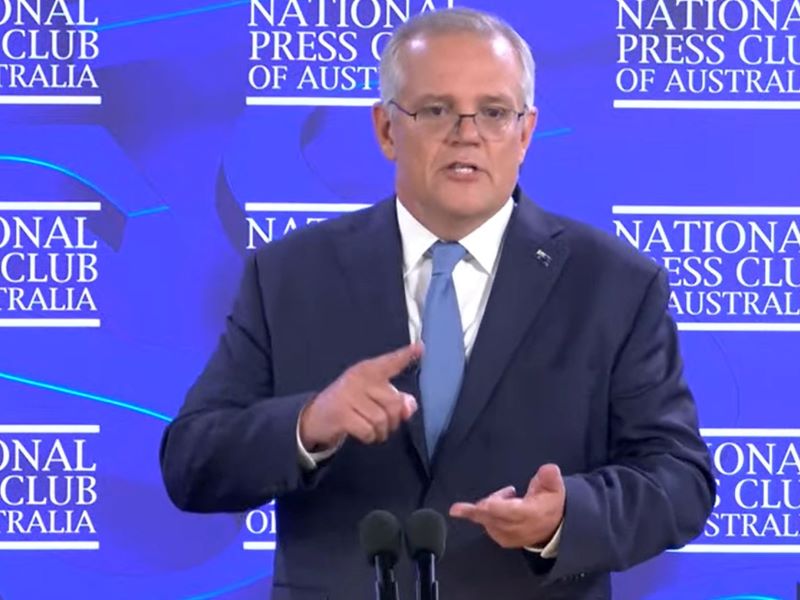Main Sequence Ventures will receive a $150 million top-up and innovators will be able to access staged accelerator funding under the federal government’s $2 billion commercialisation package, which aims to help researchers bridge the “valley of death”.
Prime Minister Scott Morrison unveiled the $2 billion Research Commercialisation Action Plan at the National Press Club on Tuesday afternoon, in an effort to align Australia’s research with the six priority sectors under the government’s manufacturing strategy and to improve the country’s long-standing commercialisation woes.
The funding comes from the $16 billion set aside in last year’s Mid-Year Economic and Financial Outlook listed merely as “decisions taken but not yet announced”.
The plan will take the Coalition’s $1.5 billion Modern Manufacturing Strategy to “the next level” by “fusing” it with the investment in research, Mr Morrison said.

The large bulk of the cash will be going towards the $1.6 billion Australia’s Economic Accelerator, a three-stage program for turning early-stage research into viable businesses. This includes a $150 million boost for CSIRO’s Main Sequence Ventures, which will be handling the third and final stage of the program.
The program is about building Australia’s national resilience, Mr Morrison said in the speech.
“We need to accelerate the forging of linkages between Australian industry and Australian university researchers. We need to find and develop a new breed of research entrepreneurs in Australia,” Mr Morrison said.
“When it comes to driving commercialisation outcomes, the key policy challenge concerns the so-called ‘valley of death’ – where early-stage research is frequently not progressed to later stages of development because of the risk and uncertainty about commercial returns.
“We know this is not insurmountable. Other countries have made a better fist of solving this problem and the government’s expert panel made a point of looking at this evidence in detail.”
Under the first two stages of the new accelerator program, research projects will compete for funding after proving their viability and commercial potential.
Under stage one, nearly 100 grants per year of up to $500,000 will be on offer. Stage two grants will go to 36 recipients worth up to $5 million, on a 50-50 co-investment basis.
The third stage will operate through Main Sequence Ventures, aiming to “catalyse” venture capital investment in Australia R&D to take them to market. Fifty companies will receive support across two rounds worth a total of $150 million.
“The fund will allow Australian innovators to access funding opportunities for each stage of their project provided they can continue to prove project viability and commercial potential. Industry involvement and engagement is required at every stage,” the Prime Minister said.
The package also includes $296 million for 1,800 new PhDs and fellowships in industry-focused disciplines, which will address “people and culture” issues in the sector, Mr Morrison said.
“At the moment, only 40 per cent of Australia’s researchers work in private industry – well below the OECD average. This together with low mobility between industry and the university sectors leads to culture and capability gaps that reduce the ability of Australian businesses to innovate,” he said.
“To tackle this issue, the government will invest in a new suite of industry PhD and research fellowship schemes to create Australia’s new generation of research entrepreneur. This $2.2 billion university research commercialisation package, and its accompanying action plan, will focus the considerable research power of our universities on Australia’s national economic priorities.”
The Coalition has had a newfound focus on improving Australian commercialisation since the 2020 budget, where it provided $5.8 million for a study scoping commercialisation efforts. This study has been led by Siemens Australia chairman Jeff Connolly.
The first outcome of this study was for the government to move to standardise university commercialisation contracts late last year. The new scheme is mandatory for all federally-funded research projects that engage in commercialisation.
Late last year Mr Morrison also announced the $242.7 million Trailblazers program, with four universities to receive up to $50 million each to establish industry-targeted, commercialisation research hubs to foster better collaboration with the private sector.
A shortlist of eight universities vying for this funding was announced last week by the federal government.
Early last year, education minister Alan Tudge questioned the value of traditional investment in research, signalling the revamped funding announced this week. Mr Tudge emphasised the need for universities to better commercialise research, questioning whether there are adequate outcomes from the $12.5 billion invested in research by the government.
A number of university vice-chancellors have urged caution with the new focus on commercialisation, saying it can’t come at the expense of fundamental research work or international research collaborations.
There has also been uproar over acting education minister Stuart Robert’s decision late last year to veto six research grants that had been recommended by an independent advisory group.
Do you know more? Contact James Riley via Email.

